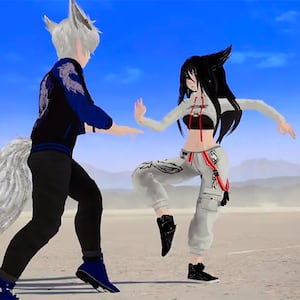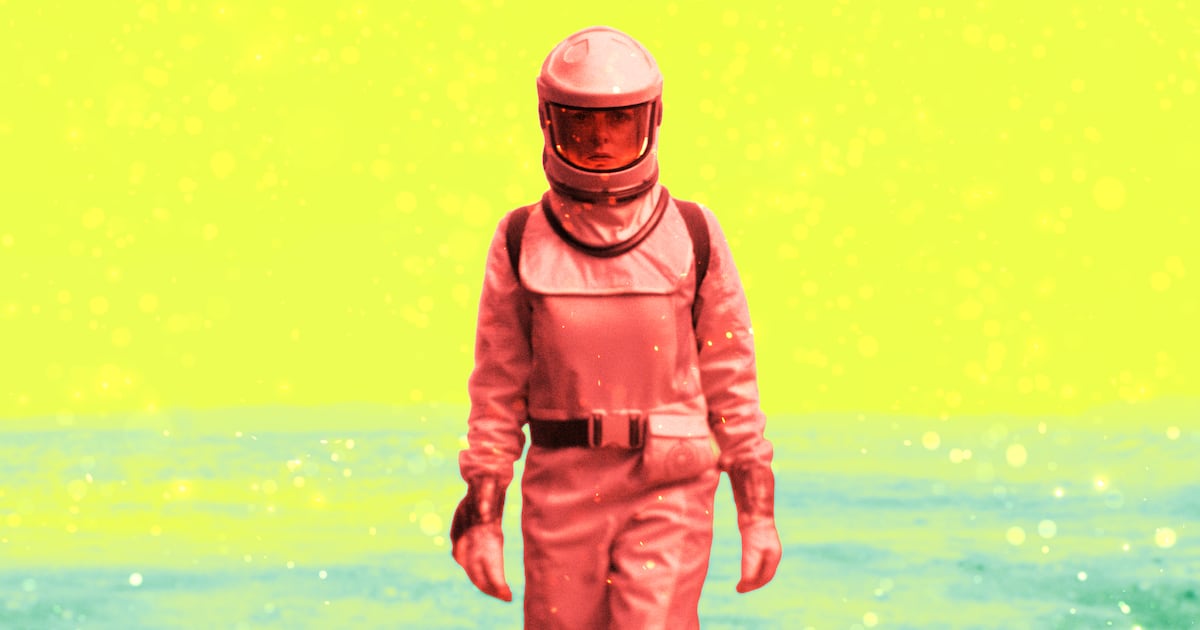DustBunny, a woman with black hair and matching fox ears, has never been to New York before. We’re seated across from each other in a small room in a Brooklyn office building, converted from a can manufacturing plant. This is exciting, even novel for her—to attend a screening in the big city for a new movie she stars in.
But in the movie, the breathtaking new documentary We Met in Virtual Reality, DustBunny goes to far more exciting places than New York. With her boyfriend, Toaster, she goes to the desert and rides giant camels. She leads a ballroom dance class for anime characters and talking animals. She gets on a private jet and flies to another dimension. She gets virtual-drunk on virtual-alcohol with her virtual-friends.
DustBunny—that’s just her handle, by the way; not her real name—is just one of the tens of thousands of people who log into the social gaming platform VRChat on a regular basis. With a microphone, virtual reality headset (like the Meta Quest or the HTC Vive), and motion-tracking sensors, she and her We Met in Virtual Reality co-stars have crafted lives for themselves within VRChat’s world. They inhabit customized 3D avatars (which look curiously similar to the humans I met IRL, at the screening), meet people from across the planet, and travel to fantastical, dreamlike worlds on a whim.
And now, thanks to 23-year-old British filmmaker Joe Hunting, these VRChat players are also movie stars.
We Met in Virtual Reality, which premiered on HBO and is now streaming on HBO Max, is an intimate look at some of the real people populating one of the biggest virtual reality worlds out there. (Think the Metaverse, but without Mark Zuckerberg’s involvement.) Shot over several months from 2020 to 2021, the documentary is a refreshing portrait of living online. But most impressively, it makes you consider what the future of love and relationships might look like.
“I was really fascinated and excited by the communities [in VRChat] and the creative expression that everyone was pursuing in making worlds and avatars,” Hunting tells me during an in-person interview ahead of the Brooklyn screening. (He’s never been to New York before, either, by the way.) As a film school student interested in making documentaries, he decided to use VRChat as the subject of his art. “I made my first short documentary investigating the social and emotional aspects and reactions to being in a headset and being in VR [in 2019], and that led me down a path of curiosity for wanting to celebrate that community and those stories.”
When the pandemic happened and people around the world were sent into lockdown, he and myriad others looked for different ways to socialize. He already had one in VRChat, where he realized there was potential to tell an even bigger story about the platform than he’d previously attempted.
“All of a sudden I had this context of isolation, and everyone was really struggling with online communication,” he says. “VRChat at that time really became a second home to me… There was no better time to make a feature film about the community that I kind of was raised in and wanted to share.”
Not only was Hunting going to make a movie set in VRChat, but he wanted to film it entirely within VRChat. Thanks to the use of an in-game camera, a user-made tool that allows players (and their avatars) to film within VRChat itself, the result is unlike any documentary you’ve ever seen.
It’s direct footage of the game, featuring vérité cinematography: Characters speak directly to the camera, answering questions Hunting asked off-screen. Hunting uses familiar conventions like close-ups and wide shots to tell his story, along with establishing shots of spaces like VR dance clubs and school buildings. It doesn’t look as if you’re playing VRChat—no first-person stuff, and no pesky on-screen prompts or text boxes. Instead, We Met in Virtual Reality looks like any other beautifully shot, designed, and scored documentary… except that all the people and places are 3D models.
Those 3D models are willing participants that Hunting scouted from throughout the platform. He wanted farflung players with interesting stories, people who were striving for connection through VR at a time when it was hard to find elsewhere.
That led him to people like DustBunny and Toaster, who lived in different countries and met on the platform. He also found IsYourBoi and DragonHeart, a couple who met dancing at a virtual exotic dance club and got married in-game, and Jenny0629, a pink-haired woman with anime eyes and glasses, who teaches sign language classes to other players.

“When Joe approached me initially to be included in the film, I definitely imagined it more like a little YouTube project,” Jenny says. “I’ve been included in several other YouTube videos and stuff like that, so I was definitely not afraid to talk about my community.”
Jenny, who has a dyed-pink ponytail and large, happy eyes, has an auditory processing disorder. She’s able to sign virtually thanks to controllers made for precise hand gestures. “I thought initially that it would be much more focused on a broader portrait of the deaf and hard of hearing in VRChat. So I was really humbled that Joe also wanted to share more personal stories and go more in depth about the emotional aspects of VR, which was a very different experience for me.”
The 90-minute film spends time with each character as they go about their daily virtual lives and give talking head interviews to the “camera.” For Jenny, that means teaching interested players how to sign words like “Christmas,” “crying,” and “transgender.” Talking to Hunting about how finding the VRChat deaf community gave her online and offline lives more meaning. While she happily talks about the group Helping Hands, whose sign-language classes attract more than 2,000 VRChat players internationally interested, she eventually opens up on camera even more: She talks about a suicide attempt that landed her in the hospital in 2019, not long after she first joined VRChat.
Her truly human willingness to talk about this gives even more resonance to one of We Met in Virtual Reality’s most engrossing moments. She interprets for her friend Ray_Is_Deaf, who only communities through ASL, as he talks about his brother’s recent suicide. When he told his friends from Helping Hands, he explains, they sent flowers to his family’s doorstep. We then watch as Jenny and Ray light an oversized lantern, blessing it with a farewell message for Ray’s brother, then sending it off into the dark-blue virtual sky.
A moment like this feels completely vulnerable, something any documentary about the human condition might tell. That it’s all in VR completely falls away, thanks to Hunting’s tender filmmaking.
“It felt like [Hunting] was doing it for us, even though it’s his documentary,” Toaster says of the participants’ willingness to bare their souls and real selves to the director. (While his avatar is a cool-looking anime guy with white hair, Toaster looks like a nice, normal guy offline, by the way.) “It felt very much that he’s trying to get our experiences and our voices out there.”
In the case of DustBunny and Toaster, their VRChat experience has a direct relationship to their real-world one. The film shows the couple not only “hugging” and “kissing” (as much as those are possible in a game with no tactile sensation), but talking about their desires to see each other in person again.
“Being able to interact in VRChat helped the long distance relationship quite a bit, obviously, because you can do activities together,” DustBunny says. (She somehow actually does have black hair and black fox ears in real life too.) “It’s like a phone call, but you actually see each other moving. So it’s way better than just a video call. You can play games together.” Even though they live thousands of miles apart, dancing and partying and traveling around VRChat’s many worlds helped DustBunny and Toaster make friends they could share as a couple, Toaster explains.
It helps that the We Met In Virtual Reality press tour is giving the couple more opportunities to connect in-person now too, now that their countries’ border restrictions are lifting. “I don’t think me and her would have spent this much physical time in this short amount of time without the film, because this gives us a reason to go, and so that’s something to be grateful for on my side, for sure,” Toaster says.
While We Met In Virtual Reality undoubtedly is an honest portrayal of what life can look like in virtual reality, it’s still a documentary—that is to say, its stars still understood that Hunting was a filmmaker, and his avatar visually held a camera pointing in their faces.
“Even if Joe didn’t add any music, didn’t add any cuts, it still would not be 100 percent authentic, because people are always going to put on a persona when they’re in VR,” says Jenny. “Just automatically when I put on my headset, I start speaking in a slightly different way. I start moving my body in a slightly different way. For me, I feel more confident in VR… I think everyone will automatically just start to be somebody slightly different than their real-life self.”
Yet the appeal of VRChat is that it allows anyone to be anything, whether it’s an anime girl with a tail and gigantic boobs, a talking hot dog, or Kermit the Frog. (All of these avatars appear in the film, and then some.) In VRChat, DustBunny and Toaster can hop on a plane and visit each other in seconds. A player who has never driven a car in real life can drive all their virtual friends around in a Jeep, blasting tunes with the top down. IsYourBoi can wear a beautiful, custom-made wedding dress to the altar, which is lovingly filmed in one of the doc’s most heartfelt scenes.
Like all social media, however, VRChat is not without its problems. The platform has made headlines in the past for instances of racism, sexism, harassment, grooming, and other toxic behaviors. While there are abundant moderation tools—and the prohibitive costs of virtual reality gear means the player base is fairly self-selecting—VRChat is a free-to-use platform that subsists on user-generated content. There’s only so much its developers can do to stop the problems before they spread.
Little-to-none of that behavior is on display in We Met In Virtual Reality; this is a story about love, friendship, and acceptance, not an exposé. That the film paints a rosy picture of the platform is not lost on its director and cast.

“That’s one of the negative things that’s happened, is that people think we’re portraying VRChat as this most amazing game with an amazing community,” DustBunny says. “But you have to actually dive deep into the game to be part of a community that means something like ours.”
“It’s your job as a player, as a user, to find those good people, and it’s hard,” Jenny adds. “It took me a long time to find my people, and I’m sure it took you guys a very long time to find your people. And even to this day, I will walk into a world and be like, ‘What is this horrible human being doing?’”
But for the cast, it’s a gift to have something they can share with friends and family that does represent the less-discussed virtues of the platform. It’s a world they spend much of their waking hours in after all—one that has dramatically altered their real lives. To people who can’t fathom what they’re doing wearing those hefty headsets all day long, We Met In Virtual Reality is a beautiful explanation.
“There is so much media about negative aspects of the internet and social media and VRChat as well,” Hunting says. “The film is countering that. It's my intention not to ignore the issues and the harassment that we've all faced in those worlds, but to show where we can get to if we are positive, when we do treat each other with respect and want to engage in meaningful relationships.
“I hope you’ll feel that and see where we can go, if we connect in the right way.”







